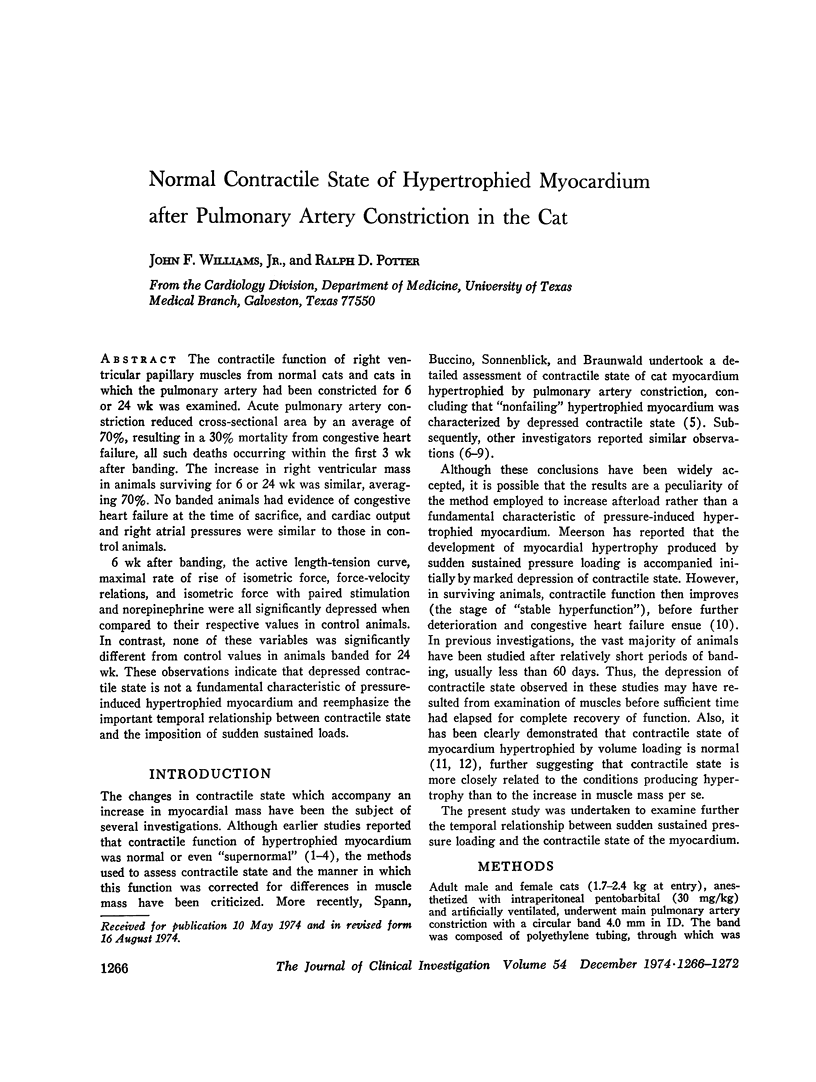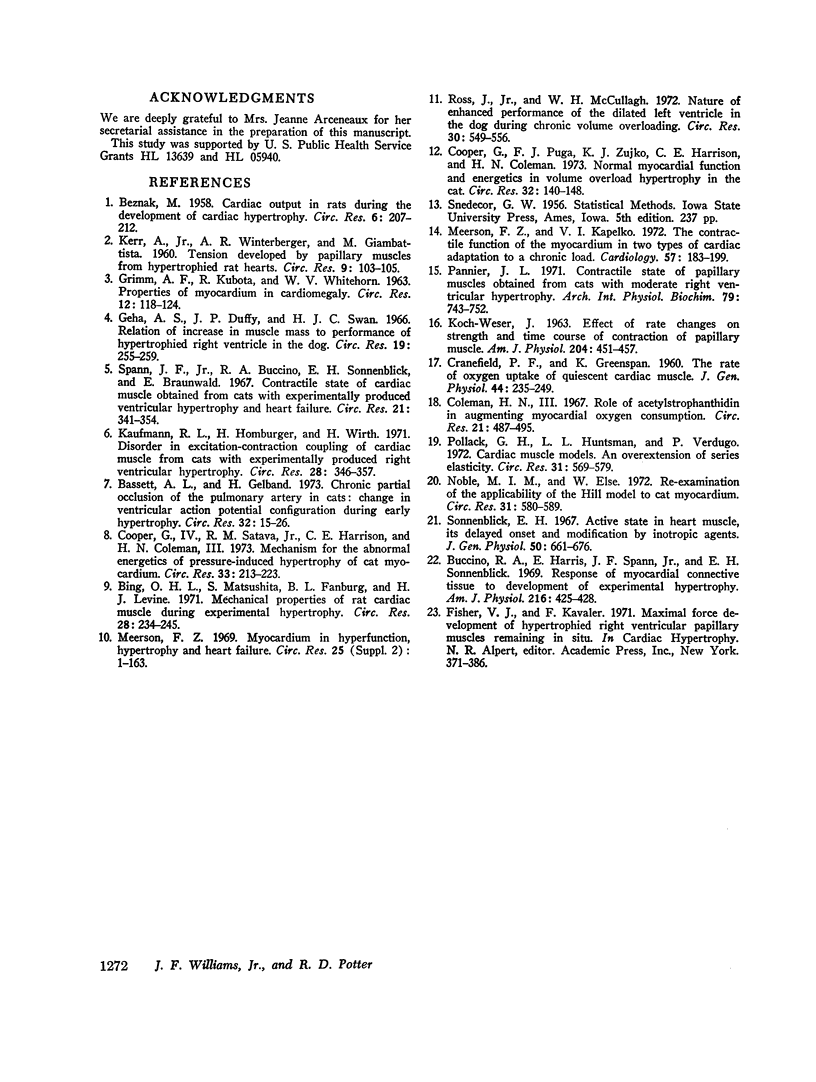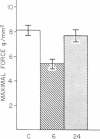Abstract
The contractile function of right ventricular papillary muscles from normal cats and cats in which the pulmonary artery had been constricted for 6 or 24 wk was examined. Acute pulmonary artery constriction reduced cross-sectional area by an average of 70%, resulting in a 30% mortality from congestive heart failure, all such deaths occurring within the first 3 wk after banding. The increase in right ventricular mass in animals surviving for 6 or 24 wk was similar, averaging 70%. No banded animals had evidence of congestive heart failure at the time of sacrifice, and cardiac output and right atrial pressures were similar to those in control animals.
6 wk after banding, the active length-tension curve, maximal rate of rise of isometric force, force-velocity relations, and isometric force with paired stimulation and norepinephrine were all significantly depressed when compared to their respective values in control animals. In contrast, none of these variables was significantly different from control values in animals banded for 24 wk. These observations indicate that depressed contractile state is not a fundamental characteristic of pressure-induced hypertrophied myocardium and reemphasize the important temporal relationship between contractile state and the imposition of sudden sustained loads.
Full text
PDF






Images in this article
Selected References
These references are in PubMed. This may not be the complete list of references from this article.
- BEZNAK M. Cardiac output in rats during the development of cardiac hypertrophy. Circ Res. 1958 Mar;6(2):207–212. doi: 10.1161/01.res.6.2.207. [DOI] [PubMed] [Google Scholar]
- Bassett A. L., Gelband H. Chronic partial occlusion of the pulmonary artery in cats. Change in ventricular action potential configuration during early hypertrophy. Circ Res. 1973 Jan;32(1):15–26. doi: 10.1161/01.res.32.1.15. [DOI] [PubMed] [Google Scholar]
- Bing O. H., Matsushita S., Fanburg B. L., Levine H. J. Mechanical properties of rat cardiac muscle during experimental hypertrophy. Circ Res. 1971 Feb;28(2):234–245. doi: 10.1161/01.res.28.2.234. [DOI] [PubMed] [Google Scholar]
- Buccino R. A., Harris E., Spann J. F., Jr, Sonnenblick E. H. Response of myocardial connective tissue to development of experimental hypertrophy. Am J Physiol. 1969 Feb;216(2):425–428. doi: 10.1152/ajplegacy.1969.216.2.425. [DOI] [PubMed] [Google Scholar]
- CRANEFIELD P. F., GREENSPAN K. The rate of oxygen uptake of quiescent cardiac muscle. J Gen Physiol. 1960 Nov;44:235–249. doi: 10.1085/jgp.44.2.235. [DOI] [PMC free article] [PubMed] [Google Scholar]
- Coleman H. N., 3rd Role of acetylstrophanthidin in augmenting myocardial oxygen consumption. Relation of increased O-2 consumption to changes in velocity of contraction. Circ Res. 1967 Oct;21(4):487–495. doi: 10.1161/01.res.21.4.487. [DOI] [PubMed] [Google Scholar]
- Cooper G., 4th, Puga F. J., Zujko K. J., Harrison C. E., Coleman H. N., 3rd Normal myocardial function and energetics in volume-overload hypertrophy in the cat. Circ Res. 1973 Feb;32(2):140–148. doi: 10.1161/01.res.32.2.140. [DOI] [PubMed] [Google Scholar]
- Cooper G., 4th, Satava R. M., Jr, Harrison C. E., Coleman H. N., 3rd Mechanisms for the abnormal energetics of pressure-induced hypertrophy of cat myocardium. Circ Res. 1973 Aug;33(2):213–223. doi: 10.1161/01.res.33.2.213. [DOI] [PubMed] [Google Scholar]
- GRIMM A. F., KUBOTA R., WHITEHORN W. V. Properties of myocardium in cardiomegaly. Circ Res. 1963 Jan;12:118–124. doi: 10.1161/01.res.12.1.118. [DOI] [PubMed] [Google Scholar]
- Geha A. S., Duffy J. P., Swan H. J. Relation of increase in muscle mass to performance of hypertrophied right ventricle in the dog. Circ Res. 1966 Aug;19(2):255–259. doi: 10.1161/01.res.19.2.255. [DOI] [PubMed] [Google Scholar]
- KERR A., Jr, WINTERBERGER A. R., GIAMBATTISTA M. Tension developed by papillary muscles from hypertrophied rat hearts. Circ Res. 1961 Jan;9:103–105. doi: 10.1161/01.res.9.1.103. [DOI] [PubMed] [Google Scholar]
- KOCH-WESER J. Effect of rate changes on strength and time course of contraction of papillary muscle. Am J Physiol. 1963 Mar;204:451–457. doi: 10.1152/ajplegacy.1963.204.3.451. [DOI] [PubMed] [Google Scholar]
- Kaufmann R. L., Homburger H., Wirth H. Disorder in excitation-contraction coupling of cardiac muscle from cats with experimentally produced right ventricular hypertrophy. Circ Res. 1971 Mar;28(3):346–357. doi: 10.1161/01.res.28.3.346. [DOI] [PubMed] [Google Scholar]
- Meerson F. Z., Kapelko V. I. The contractile function of the myocardium in two types of cardiac adaptation to a chronic load. Cardiology. 1972;57(4):183–199. doi: 10.1159/000169518. [DOI] [PubMed] [Google Scholar]
- Meerson F. Z. The myocardium in hyperfunction, hypertrophy and heart failure. Circ Res. 1969 Jul;25(1 Suppl):1–163. [PubMed] [Google Scholar]
- Noble M. I., Else W. Reexamination of the applicability of the Hill model of muscle to cat myocardium. Circ Res. 1972 Oct;31(4):580–589. doi: 10.1161/01.res.31.4.580. [DOI] [PubMed] [Google Scholar]
- Pannier J. L. Contractile state of papillary muscles obtained from cats with moderate right ventricular hypertrophy. Arch Int Physiol Biochim. 1971 Oct;79(4):743–752. doi: 10.3109/13813457109084951. [DOI] [PubMed] [Google Scholar]
- Pollack G. H., Huntsman L. L., Verdugo P. Cardiac muscle models. An overextension of series elasticity? Circ Res. 1972 Oct;31(4):569–579. doi: 10.1161/01.res.31.4.569. [DOI] [PubMed] [Google Scholar]
- Ross J., Jr, McCullagh W. H. Nature of enhanced performance of the dilated left ventricle in the dog during chronic volume overloading. Circ Res. 1972 May;30(5):549–556. doi: 10.1161/01.res.30.5.549. [DOI] [PubMed] [Google Scholar]
- Sonnenblick E. H. Active state in heart muscle. Its delayed onset and modification by inotropic agents. J Gen Physiol. 1967 Jan;50(3):661–676. doi: 10.1085/jgp.50.3.661. [DOI] [PMC free article] [PubMed] [Google Scholar]
- Spann J. F., Jr, Buccino R. A., Sonnenblick E. H., Braunwald E. Contractile state of cardiac muscle obtained from cats with experimentally produced ventricular hypertrophy and heart failure. Circ Res. 1967 Sep;21(3):341–354. doi: 10.1161/01.res.21.3.341. [DOI] [PubMed] [Google Scholar]




